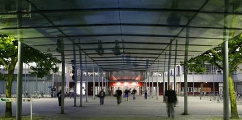CeBiTec Colloquium (unscheduled)
Friday, June 7th 2013, 15 c.t.
G2-104, CeBiTec Building
Prof. Dr. Caroline Friedel
Lehr- und Forschungseinheit BioinformatikInstitut für Informatik, Ludwig-Maximilians-Universität München
Characterization of mRNA splicing kinetics and pathogen infection using next-generation sequencing
Next generation sequencing (NGS) technologies provide novel opportunities for transcriptomic analyses beyond simple quantification of gene expression. Recently, we showed that the combination of RNA sequencing with metabolic labeling of newly transcribed RNA provides unparalleled insights into the kinetics of RNA splicing and processing. Using ultra-short and progressive labeling, we identified classes of rapidly and slowly spliced/degraded introns and showed that most small nucleolar (sno)RNA-containing introns are processed inefficiently with the majority of introns spliced and degraded rather than processed into mature snoRNAs. As one of the major challenges in analyzing RNA-seq data is the identification of the transcriptomic origin of each sequencing read (mapping), we recently also developed the ContextMap mapping algorithm. In contrast to other state-of-the-art mapping tools, ContextMap makes use of information provided by reads mapped to the same genomic region and likely originating from transcripts of the same gene. Thus, it does not aim at finding the mapping with the minimum number of mismatches, but the most likely mapping in the context of all other reads. For this purpose, it allows a high degree of ambiguous mappings in intermediate steps, resolving these only in a final integrating step to obtain a unique mapping for each read. This strategy allows simultaneous mapping of reads against several different potential sources of reads, e.g. all microbial and viral genomes in addition to the host genome to identify and characterize pathogen gene expression in the host and identify previously unknown associations between pathogen infection and diseases.
Host: Prof. Dr. Jens Stoye



